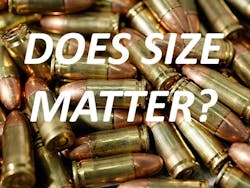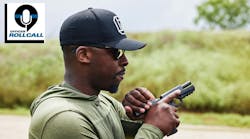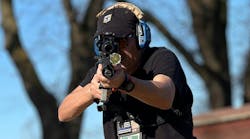It seems every year police officers get involved in the same debate about ammunition. Everyone has their favorite round, and once someone settles on a certain caliber, it’s difficult to persuade them that perhaps there might be something better.
I’m a former police officer and retired FBI agent. I’ve been a firearms instructor for years and I was the principal firearms instructor for the Detroit FBI division. As such, I had the responsibility of following studies on handguns and ammunition. I also taught at the FBI Academy and was able to observe firsthand the testing of weapons and ammunition. That’s why I place a lot of credence on FBI testing. That said, their recent recommendation what round law enforcement should carry might surprise you.
When I taught street survival classes around the world, one block of instruction was devoted to ballistics, particularly terminal ballistics. We discussed different calibers and showed videos of people being shot and the body’s reaction when a round impacts it. Additionally, we talked about people’s perceptions concerning different handgun rounds and the role Hollywood plays in creating myths about how people react to being shot. Much of what folks believe concerning stopping power still comes from movies and television. I think the folklore and myth began with Dirty Harry movies. Clint Eastwood’s .44 magnum revolver could stop just about anything.
But what is stopping power? Is it knocking down a threat; immediately incapacitating a threat; slowing down a threat? What is the reality? Much of contemporary ammunition testing uses ballistic gel. The result of that testing, combined unfortunately with influential marketing by ammunition manufacturers, helps agencies decide which caliber and/or bullet type their officers will carry. However, a much better indicator of a certain round’s effectiveness comes from people who see actual results of the damage a bullet inflicts. The people I’m referring to are trauma surgeons.
Doctor Sydney Vail is a full time Trauma & Emergency Surgery doctor, as well as senior instructor for the International School of Tactical Medicine in Palm Springs, CA. Vail’s answer to the question about stopping power: “There is only one way to instantly incapacitate someone—destroy the brainstem.” Snipers use this as their mantra and have the training and weaponry to deliver the result. But what about the police officer on the street? What handgun round is most effective to “stop” an individual? There is no easy answer, the doctor insists.
Vail’s definition of stopping power is: “. . . a particular ammunition’s effectiveness to render a person unable to offer resistance or remain a threat to the officer, an intended victim, or self.” He then adds no single ammunition can reliably claim to have superior stopping power. So what is the magic bullet? Shot placement.
Getting back to the latest FBI testing, the agency emphasizes handgun stopping power is a myth. Their testing indicates “the single most important factor in effectively wounding a human target is to have penetration to a scientifically valid depth (FBI uses 12-18 inches).”In that regard, they say contemporary 9mm Luger offerings are outperforming most of the premium line .40 S&W and .45 Auto projectiles similarly tested by the FBI.
That reinforces the reason why many police departments are returning to the 9mm round for their duty weapons. But it’s not only the ballistic tests that drive the decision to use 9mm. There are other compelling reasons: higher magazine capacity, less recoil, lower cost in ammunition and wear on weapons, and higher functional reliability. The FBI reports their shooters increased both speed and accuracy using 9mm weapons.
The most important factor that stands out in the debate on caliber isn’t size, expansion, velocity, or penetration. There remains one constant theme regarding stopping a threat that both the FBI and trauma surgeons agree upon—bullet placement. Dr. Vail says, “One well placed shot through a major blood vessel with do a lot better job of incapacitating than an entire magazine of bullets hitting nothing but thigh muscle tissue.”
Therefore, if bullet placement is the key to incapacitating a threat, it makes sense that the 9mm is the weapon of choice. With the diversity of officers now on the job, many more females and smaller sized males, it’s prudent to arm them with a weapon they can fire easily and accurately. Gun manufactures now provide “families” of weapons, with an assortment of sizes and grips. A good fitting handgun with less recoil makes for a more accurate shooter. Moreover, with 9mm ammo costing less, and fewer weapons needing repair due to excessive wear from larger calibers, more training can be accomplished.
Having seen a variety of shooters and weapons over the years, I’d like to add one more intangible factor—confidence. I’ve seen officers show up at the range with brand new .45s or.40s, without ever having consulted myself or another instructor about the efficacy of the weapon. The only explanation they give is that the weapon will make a bigger hole and stop a bad guy in his tracks. However, once I put them through a course of fire, they realize the weapon is a poor fit. They have difficulty controlling the recoil and accuracy is minimal. Hard to stop someone if you can’t hit him.
Having confidence in your sidearm is paramount. Knowing the weapon inside and out is a must. I can’t imagine carrying a weapon I’m not 100% confident with, yet there are those who barely pass qualification yet insist on staying with the same gun.
What’s the takeaway from the FBI’s conclusion that the 9mm round is best for law enforcement? Simply this: the 9mm round gives police officers the best chance to stop a threat because it will help officers place the round accurately, thus confirming the axiom that bullet placement remains the most important factor in winning a gun battle.
Stay Safe, Brothers & Sisters!



